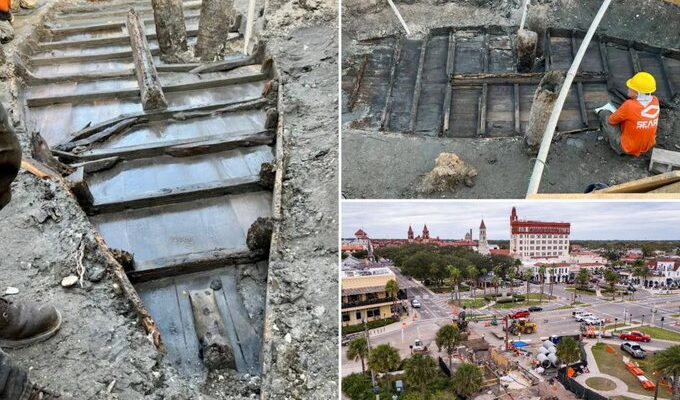
Construction crews in St. Augustine, Florida, were digging out a drainage system for a highway when they suddenly stopped. They couldn’t believe what they found. The road crew discovered an intact, centuries-old shipwreck embedded in a Florida highway.
The old, wooden fishing vessel spanned 20 feet and has been labeled as coming from the 19th century and it was labeled an “incredible find.”
FDOT had already sub-contracted with Southeastern Archaeological Research to help if something surfaced during the $4.2 million drainage pipe project that began this past spring. And sure enough, as crews dug in the mud behind a riverfront seawall, a timber section of the buried ship appeared near remains of an old dock, according to Jacksonville Today.
“We believe the vessel may have sunk unexpectedly and, over time, was silted in. That is why it was preserved so well,” FDOT District 2 Secretary Greg Evans said in a statement. “It was encapsulated in soil and mud, so there was no air contact for it to decay. It’s truly an incredible find.”
What’s left of the buried shipwreck includes decking with 12 ribs connecting what’s left of a lower hull, says James Delgado, senior vice president at SEARCH, which led this week’s excavation and recovery of the remains.
“We believe the vessel to be a small single-masted, shallow-draft sailing craft of the 19th century that was likely used to extract fish and shellfish from coastal waterways and directly offshore,” Delgado says. “With a dedicated team, including support from the local community and the on-site construction team, we were able to extract the vessel in order to allow the important work on the community’s infrastructure to continue.”
In an interview with Newsweek, Ian Pawn, an archeologist at the Florida Department of Transportation, to get more details about the unusual find.
“The vessel was buried under nearly 8-10 ft of sediment and later St. Augustine development, such as the eastward extension of the seawall, fill, and portions of the early 20th century trolley station. A large palm wood piling was even driven through the vessel (likely for tying off ships), indicating that the vessel was not known even in [the] later 19th century/early 20th century…A great deal of research still has to be done, and we may never know these exact details,” he said.
🚨 PHOTO RELEASE 🚨 Check out photos from our #transportation project with @MyFDOT_NEFL that unearthed a 19th-century shipwreck beneath historic #StAugustine 👉 https://t.co/GJ648zacR0.#CulturalHeritage #Shipwreck #FDOT
Follow @SEARCH_Inc for project updates. pic.twitter.com/Im4NLGDYMX
— SEARCH (@SEARCH_Inc) October 13, 2023
Although experts cannot say for sure, Pawn noted that it was likely a sailboat.
“The vessel is what is known as vernacular, which means it was likely built locally, with local materials, for domestic use. The artifacts, many located atop the buried vessel, helped confirm the initial dating of the vessel,” Pawn said. “Finds included leather shoes (including different shoes for left and right, a 19th century innovation), coins (one dated to 1869), coconut halves that were likely used as cups, and a portion of an oil-fired lantern.”
Newsweek explained that “at the moment, archaeologists are working to ‘stabilize the vessel.’ Pawn said that when an object is found ‘this well preserved’ archeologists only have a short amount of time to extract it. This is because the drying of the wood will begin the decaying process.”
“The boat was disassembled, plank by plank, and removed, with great care to keep each portion wet,” Pawn explained. “The pieces will be observed in wet storage to stabilize as we determine future preservation effort. We will be working closely with archaeologists and the City of St. Augustine to find a permanent home for this unique find.”
FDOT thanked SEARCH’s “careful efforts to preserve this vessel,” writing that “With every project we undertake, the Florida Department of Transportation is sensitive to the unique needs of the communities we serve, including the potential presence of historical sites and artifacts within construction sites. We look forward to learning more about its significance to the region.”









